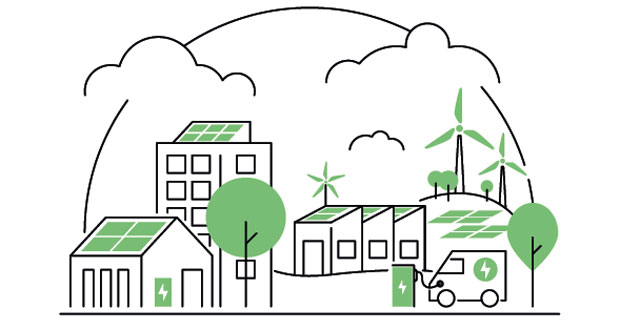 THE IWFM CHAIR’S VIEW
THE IWFM CHAIR’S VIEW
MARK WHITTAKER,
GENERAL MANAGER,THOMSON FM & CHAIR, INSTITUTE OF WORKPLACE & FACILITIES MANAGEMENT (IWFM)
The straightforward answer to the question being posed, in my opinion, is “Yes” and “Yes”, but would like to expand upon that further for clarity.
I suppose the first part is to understand the reason for the increased demand for more sustainable corporate office space. There are two obvious reasons for me from an operational and then ethical standpoint.
Firstly, we read a lot about the “war on talent” in which companies face stiff competition to attract and then retain their people. Some argue that creating a sustainable workplace environment is an effective means to positively highlight an organisation’s sustainability values, with research showing that more and more members of the workforce tend to value this highly in their decision making. Thus, it can have a significant influence on people wanting to join or continue to work for that organisation. In addition, other benefits of sustainable workplaces could include enhanced brand reputation, energy efficiency and creating an improved workplace experience, which some align to productivity gains.
The second element from an ethical/moral point of view is that organisations want to demonstrate how seriously they recognise the climate change crisis to be and the level of proactively they are prepared to take to try and tackle it. As we know the crisis has been a constant feature in the news, whether that be the “Stop Oil” protests or the wild fires which have raged across Europe and parts of America recently. This is why organisations want their workplaces to be a symbol of their climate change actions.
The point also to be made is that the movement to higher rents for more sustainable corporate offices might simply be market forces at work; i.e. straightforward supply and demand economics, where the supply for future proofed, sustainable workplaces is not currently meeting demand, resulting in the price increases mentioned.
Earlier this year the IWFM Outlook Survey was published and amongst the many insights provided was the increased importance given by many to the management of energy efficiency and sustainability goals within the workplace. In short, significant numbers of respondents told us that sustainability is an important positive catalyst for the FM market.
Many in the profession believe that the achievement of net zero is the biggest challenge facing the built environment, with pressure mounting. Indeed earlier this month, IWFM partnered with Mitsubishi to produce a roundtable report on ‘The role of FM and building services in achieving net zero and energy efficiencies’.
Some of the key takeaways from the session was that facilities management professionals needed to “step up” and embrace the fact that they have a key role to play in the achievement of organisational sustainability and carbon net zero goals, with aligned themes of flexibility, collaboration and looking at effective means to innovate.
The roundtable discussion also called for greater consistency in data reporting across the sector and in the case of retrofitting, that suppliers and their supply chain needed to be given the opportunity to be more pro-active and imaginative in coming forward with their sustainable solutions.
 THE ESG CONSULTANT’S VIEW
THE ESG CONSULTANT’S VIEW
DR SOPHIE TAYSOM,
FOUNDER & DIRECTOR KEYAH CONSULTING
Sustainability attributes in commercial real estate are, as we know, commanding a ‘green premium’. Alongside this, changes in building requirements including minimum energy efficiency standards (MEES) are establishing an important baseline in terms of sustainability requirements.
My answer to the question as to which should take priority, either enhancing a small number of buildings to attract premiums or having robust sustainability standards in place, is that we need both.
In the next couple of years, we’re likely to see a convergence of the two. What we think of and price in as a green premium now will increasingly become the norm. There will still be some element of premiums attached to the best in class in terms of sustainability credentials, but the gap will reduce.
There are a number of push and pull factors at play.
Building and energy requirements are important. In addition, over the last couple of years we’ve seen the ‘flight’ from the office with hybrid working in greater demand. This is having an impact on space and amenity requirements. And while there is a slow return to the office with a majority of respondents to the paper from CIM, ‘Tenant Preferences in the UK Office Market’ anticipating that their business will move to at least three in-office days per week, it still marks a significant shift from pre-COVID days.
We’ve also seen a focusing of minds, not least of all due to the energy crisis, with occupiers and owners more mindful of costs. And tenants will be paying more attention to the green credentials of the assets they occupy as they start to measure and commit to their own carbon reduction strategies. They will also be paying attention to how their approach impacts on talent acquisition and retention as we know sustainability is becoming a critical factor in people’s decisions about where and with whom they work.
But there is a big price tag that comes with all of this. It’s estimated that the decarbonisation of UK public sector buildings alone will cost £25-30bn. While in commercial buildings, a good case can be made to upgrade existing stock to attract those rental premiums for now, and to future proof, there is a real risk we end up with a large number of stranded assets, particularly outside prime locations. Not all commercial buildings are suited to being repurposed.
Another complicating factor is that there remains a lack of clarity on what the sustainability requirements are going forward. The British Property Federation has called on government to publish its response to the 2021 consultation on MEES. This lack of clarity risks undermining mid and longer-term targets for Energy Performance Certificates (EPCs). Many will be taking a wait and see approach before committing to projects.
Effectively we need to do both – enhance assets are far as possible which will attract green premiums, and at the same time have clarity on minimum sustainability requirements. This poses both challenges and opportunities for the sector.
Commercial and residential contributions of all sizes will help create a greener, safer environment for generations and it is vital that we begin building ambitious, large-scale infrastructure with cutting-edge green technologies across the UK. Property designers, owners, occupiers and policy decision-makers must now determine the best way to improve building energy performance.





